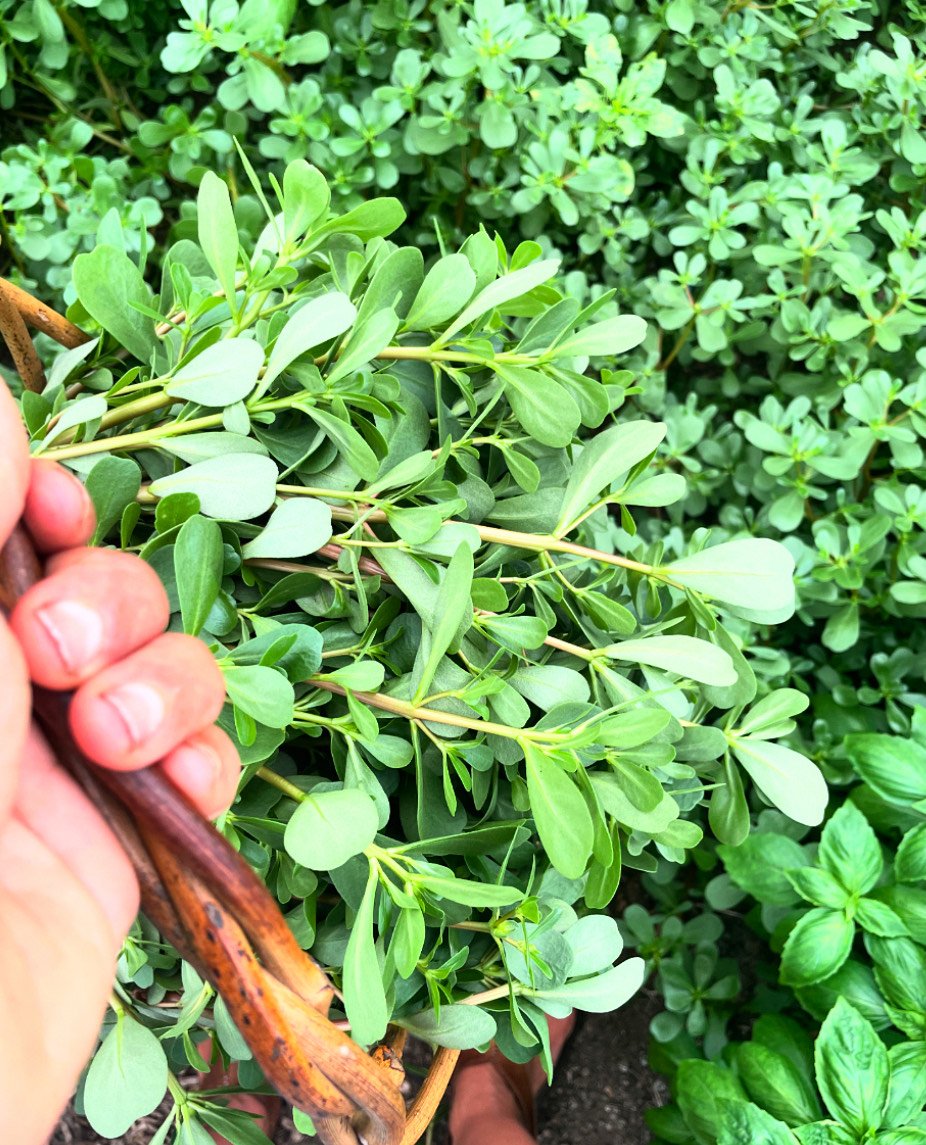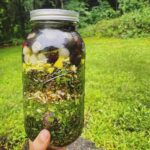
Purslane’s medicinal properties are mostly attributed to its cold and moist energetics. Loaded with mucilage, it’s a wonderful vulnerary and demulcent. Works wonderfully for Summer Heat (a pattern in TCM), excess Pitta, hot inflamed tissues (used both externally and internally), dry coughs, sore throat, and the Heat and Dry/Atrophy tissue states. Signs of excess Heat worsen in the summer and can include irritation, insomnia, headaches, getting easily overheated, and anxiety vacillating with depression. Used topically for burns, abrasions, insect bites, gout, and bruises, best as a poultice or fresh juice. Excellent for heat in the digestive and urinary systems, and skin (use topically for the skin). From Gerard’s Herbal- “It cools the blood and causes appetite.’
Supreme “food as medicine”! Purslane is delicious raw in salads, fermented, pickled, made into a relish or cooked in soups, stews, stir-fries, and so on. It is most often cooked like spinach in many traditional diets. Purslane is a nutritive herb and contains more omega-3 fatty acids (in the form of alpha-linoleic acid) than any other plant known. These essential fatty acids are beneficial for a myriad of body systems, especially the cardiovascular system, and are also anti-inflammatory. 100 g of fresh purslane leaves has been shown to contain 300 to 400 mg of alpha-linolenic acid. Particularly high in calcium, magnesium, potassium, iron, vitamin A and vitamin C. one cup (250 ml) of cooked leaves contains 90 mg of calcium, 561 mg of potassium, and more than 2,000 IUs of vitamin A. Purslane provides six times more vitamin E than spinach and seven times more beta carotene than carrots.
In Traditional Chinese Medicine (TCM) Purslane is known as Ma Chi Xian. The leaves are used for insect or snake bites (also get to a hospital- fast!), boils, sores, insect bites, dysentery and diarrhea, and bleeding from hemorrhoids, intestinal bleeding and postpartum bleeding (also- get to hospital if it’s severe!).
As a mucilage rich, demulcent herb, Purselane can be best understood as a cooling and soothing remedy for systemic dryness, digestive inflammation, and excess heat. It’s at its prime stage of harvest in mid-late summer, often when summer heat is at its peak. I consider it a food as medicine tonic we can all benefit from in the summer and anytime of year if you live in a dry, hot climate!
Seeds…
Vermifuge. From A Modern Herbal: “The seeds, bruised and boiled in wine, were given to children as a vermifuge.”
Preparations & Dosage: As food- raw, cooked, pickled or fermented; topically as a tea/compress/poultice; herbal vinegar (and/or pickled!); tea (let steep until it’s cooled to best extract the mucilage); fresh juice
Contraindications: In TCM it is contraindicated during pregnancy and for those with cold and weak digestion. The oxalates can irritate the kidneys in high amounts, so this should be avoided by folks with a history of kidney stones or folks with weak or compromised kidneys or kidney disease.
More:
Known to medicine since at least the time of Hippocrates (c. 460 BC), who wrote about its use for heat in the urinary system. Dioscorides wrote of its use for heat in the digestive system and Galen for heat in the mouth. Cultivated in ancient Egypt and was a common vegetable in the Roman empire. Pliny the Elder (AD 23 – August 25, AD 79) discussed Purslane as an amulet to be worn to expel all evil.
Wonderful food as medicine enjoyed in cuisines the world over from China to India to the Mediterranean, Levant, North America and Mexico. Wherever humans encountered this plant they wove it into their culinary traditions. Crunchy, sour and mucilaginous when eaten raw, it softens and cooks down somewhat like spinach when cooked and adds its mucilage and slightly sour flavors to dishes when cooked. The entire aerial portions (leaves + stems) can be eaten raw or cooked and the flowers can be consumed as well. Once it goes to seed it can still be eaten but it begins to decline, since it’s an annual, so be sure it looks vibrant and juicy when collecting.
Very much still a part of food traditions all throughout the Mediterranean, SWANA regions, India, Mexico, Latin America, and beyond. A common Greek recipe (it’s thought to contribute to the Cretan high-life-expectancy) is to toss the chopped stems and leaves with feta cheese, tomato, onion, garlic, oregano, and olive oil and is also boiled and used as a potherb in horta. Traditional in Italian cuisine, both raw and cooked. In the Levant it’s eaten raw in a famous salad called Fattoush as well as in numerous other dishes.




